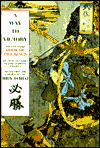
A Way to Victory: The Annotated Book of Five Rings.
Translation and Commentary by Hidy Ochiai.
Overlook Press, 2001.
ISBN: 1-58567-038-3.
162 p. 7" x 9" hardcover.
Purchase from Amazon. (paid link)
A number of years ago, I wrote a column on the classical martial arts for Aikido Journal magazine. Part of that series was an article on those books that I thought were of high quality, both for specific technical and general information. Conspicuous in its absence were any of the then current translations translation of Miyamoto Musashi's classic guide to martial strategy and swordsmanship, the Go rin no sho. I am happy to say that that gap has now been filled, and most admirably.
A Way To Victory: The Annotated Book of Five Rings is a translation of Musashi's work by Hidy Ochiai, a karatedo teacher resident in the United States. I must confess I've never heard of him before and know nothing about his background in the martial arts (the book jacket states that he is an anthropology professor at SUNY Binghampton). My unfamiliarity with him and my initial skepticism of a karate teacher doing a translation of a classical text on swordsmanship notwithstanding, I think Ochiai's rendering of Musashi's work is pretty good. He has meticulously translated each of the sections and provided explanatory end notes that help a reader who is unfamiliar with Japanese history and martial culture to understand both historical context and some of the more subtle cultural aspects. Moreover, even though Ochiai does not appear to have a background in swordsmanship, he has managed to convey the essence (as best as I can determine from the Japanese text) of what Musashi said. That is a very commendable accomplishment.
I have some relatively minor quibbles with the book. The editing should have been tighter. The text reveals several unnecessarily awkward and incorrect turns of phrase that could, and should, have been removed. Although Ochiai is to be congratulated for his effort to translate Musashi's work (and it is a very difficult one to read, even for modern Japanese), his English is not quite good enough for a text like this; I think the book would be lots better had it been cleaned up a little more.
Secondly, the use of Japanese terms in the text is not very well conceived. Orthography for Japanese words has advanced a long way since the first Japanese-English dictionaries were compiled and spellings like "kenj[I]tsu," pluralization of Japanese words like "samurai[s]," and awkward renderings for Japanese terms, such as rhythm-timing for "hyoshi," could be improved upon. As a scholar in the social sciences, it is both surprising and annoying for Ochiai to fail to use what have come to be accepted as standard methods of Japanese-English orthography.
But these are, as I said, minor quibbles. This translation of Go rin no sho is definitely worth reading and belongs in every budoka's library. The only better way to understand Musashi's work would be to train with Imai Masayuki, headmaster of the Niten Ichi-ryu. Buy the book and enjoy!
Meik Skoss
P.S. For koryu practitioners, Wilson's translation is a better bet.
A Koryu.com original.

Contact Koryu.com
Last modified on October 23, 2019
URL: https://koryu.com /books/fiverings.html
Copyright ©2022 Koryu Books. All rights reserved.
